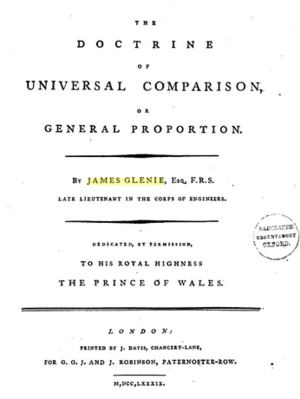James Glenie facts for kids
James Glenie (born 1750 – died 1817) was a clever Scottish soldier, businessman, and politician. He was known for his work in New Brunswick, Canada. He was a member of the Legislative Assembly of New Brunswick for Sunbury County from 1789 to 1809. He was also a Fellow of the Royal Society of Edinburgh and a Fellow of the Royal Society, which are big honors for scientists and thinkers.
Contents
James Glenie's Early Life and Education
James Glenie was born in Leslie, Fife, Scotland. His father, John Glenie, was an army officer. James went to school in Leslie. Later, he studied at the University of St Andrews. He first studied religion but became very good at mathematics. He earned his master's degree in 1769.
Joining the Military
After university, James joined the Royal Military Academy in Woolwich. He became a second lieutenant in the Royal Artillery in 1776. He served as a soldier during the American Revolution.
Later, he worked for Governor Frederick Haldimand. Glenie was asked to build army housing on an island in Lake Ontario. He had some disagreements with his commanding officer there. Because of this, he was moved to Sorel and faced a military trial. He was found guilty, but the decision was later changed.
Moving to New Brunswick
In 1779, James Glenie became a Fellow of the Royal Society. He married Mary Anne Locke in the early 1780s. In 1785, he was helping with army projects in the Saint John River area of New Brunswick. He wanted to get land there but was not successful.
He went back to England but then quit the army. In 1787, he brought his family to New Brunswick.
Business and Political Challenges
James Glenie started a business that supplied large wooden masts for ships. His business partner was based in London. However, he faced problems from Thomas Carleton, who was the governor of New Brunswick. Governor Carleton had been involved in Glenie's earlier military trial.
Glenie began to speak out against Governor Carleton and the powerful people in the province. In 1791, he was named a special surveyor for the king's forests in New Brunswick. This was suggested by John Wentworth.
In January 1794, he was also elected a Fellow of the Royal Society of Edinburgh. This was a recognition of his scientific and mathematical work.
Later Political Career
By early 1795, Glenie was no longer involved in the mast business. In 1795, he suggested a new law. This law aimed to give more power to the elected government assembly. It would give less power to the appointed legislative council.
In 1802, Glenie was a leader in a disagreement between the assembly and the council. They argued about who could choose a new clerk for the assembly. Even though Glenie was re-elected in 1802, most other members of the assembly supported the governor more than him.
Final Years
In 1804, James Glenie left New Brunswick and went to England. He left his wife, Mary Anne Locke, behind. In 1809, he was a witness in a court case. The judge, Lord Ellenborough, strongly criticized him. Because of this, James Glenie lost his good name and his jobs. He passed away in 1817 in Pimlico, London, and was buried in a churchyard there.
James Glenie's Writings and Works
James Glenie was a talented writer and mathematician. He wrote many important papers and books. Here are some of his works:
- 'The Division of Right Lines, Surfaces, and Solids' – This was published in Philosophical Transactions, a scientific journal.
- 'General Mathematical Laws which Regulate and Extend Proportion Universally' – Another paper in Philosophical Transactions.
- A Short Essay on the Modes of Defence best adapted to the Situation and Circumstances of this Island … by an Officer (1785) – A book about military defense.
- The History of Gunnery, with a new method of deriving the theory of projectiles in vacuo from the properties of the square and rhombus (1776) – A book about the science of cannons and projectiles.
- The Doctrine of Universal Comparison, or General Proportion (1789).
- Observations on Construction (1793).
- The Antecedental Calculus, or a Geometrical Method of Reasoning (1793) – This book explored a new way of thinking about geometry and math.
- Observations on the Duke of Richmond's Extensive Plans of Fortification (1805) – A book discussing military forts.
- Observations on the Defence of Great Britain and its Principal Dockyards (1807).
- He also wrote papers for the Transactions of the Royal Society of Edinburgh, including 'On the Principles of the Antecedental Calculus' and 'On the Circle'.
- He contributed articles to Rees's Cyclopædia, an encyclopedia, on topics like Artillery carriages, Cannon, and Fortification.


